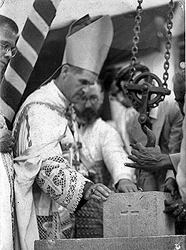Thomas Monsignor Roberts | |
|---|---|
| Archbishop Archbishop Emeritus of Bombay | |
 Roberts blessing the foundation stone of St. Peter's Church in Bandra | |
| Church | Roman Catholic Church |
| Archdiocese | Archdiocese of Bombay |
| Province | Bombay |
| Metropolis | Bombay |
| See | Bombay (emeritus) |
| Installed | 12 August 1937 |
| Term ended | 4 December 1950 |
| Predecessor | Joachim Lima SJ |
| Successor | Cardinal Valerian Gracias |
| Other post(s) | Titular Archbishop of Sugdaea |
| Orders | |
| Ordination | 20 September 1925 |
| Consecration | 21 September 1937 by Archbishop Richard Joseph Downey |
| Rank | Archbishop |
| Personal details | |
| Born | Thomas d'Esterre Roberts 7 March 1893 Le Havre, France |
| Died | 28 February 1976 (aged 82) London, England |
| Buried | Kensal Green Cemetery 51°31′41″N 0°13′03″W / 51.5281°N 0.2174°W |
| Denomination | Roman Catholic |
| Residence | London |
| Parents | William d'Esterre Roberts (father) Clara Louise Roberts (mother) |
| Alma mater | College of St Elme Parkfield School, Liverpool St Francis Xavier's College Stonyhurst St Mary's Hall |
| Motto | Carior libertas (Latin) Freedom is more precious (English) |
| Styles of Thomas Roberts | |
|---|---|
 | |
| Reference style | The Most Reverend |
| Spoken style | Your Grace |
| Religious style | Monsignor |
Ordination history of Thomas Roberts | |||||||||||||||
|---|---|---|---|---|---|---|---|---|---|---|---|---|---|---|---|
| |||||||||||||||
| |||||||||||||||
Thomas d'Esterre Roberts (7 March 1893 – 28 February 1976) was an English Jesuit prelate. He was rector of St Francis Xavier’s, Liverpool, from 1935 to 1937. He was Archbishop of Bombay, India, from 1937 to 1950 but in practice did not exercise this role after 1946 when he absented himself from the post and left his Indian auxiliary bishop effectively in charge. In 1950 he was appointed titular Archbishop of Sugdaea, modern Sudak.
After leaving Bombay, not having a regular diocesan job, he dedicated himself to lecturing, writing, and the promotion of debate on controversial issues. He held that to be effective, authority had to be accepted, not imposed. This required that it be subject to open criticism, scrutiny and review, procedures which he felt were somewhat lacking in the governance of the Church. His refusal to sweep any question under the carpet at times unnerved some church authorities[1] and gained him a reputation in some Catholic circles as a "rogue bishop"[2] or a "maverick".[3] Although others applauded his challenging insights, the controversy obscured the significance of his work in Bombay.[4]
- ^ "Obituary: Archbishop Thomas Roberts", Kay, Hugh, Letters and Notices, Volume 81, No 371, Society of Jesus, November 1976
- ^ "Archbishop Roberts Dies at 82; 'Rogue Bishop' Served Bombay". New York Times. 29 February 1976. Retrieved 10 October 2018.
- ^ Hebblethwaite, Peter (6 March 1976). "Archbishop Roberts". The Tablet. Archived from the original on 21 September 2015.
- ^ Blake, Robert; Nicholls, C.S., eds. (23 September 2004). "Roberts, Thomas D'Esterre (1893–1976)". Oxford Dictionary of National Biography 1971-1980. Oxford University Press. ISBN 0198652089.